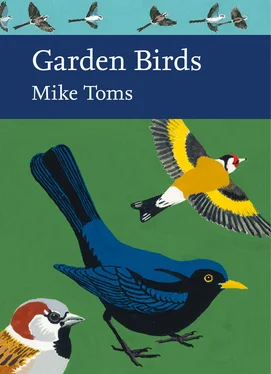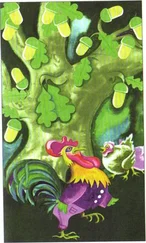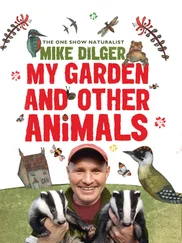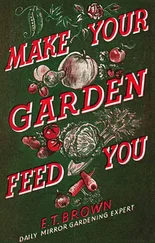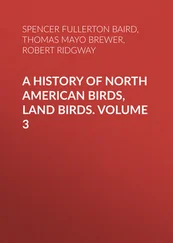1 ...6 7 8 10 11 12 ...26 Urban living may also lead to greater exposure to humans, perhaps resulting in increased tolerance of their presence and reduced levels of ‘fear’. Work on urban Great Tits has highlighted that they are less neophobic and show shorter flight initiation distances (see Chapter 6
) than their rural counterparts (Møller et al., 2015; Charmantier et al., 2017). They also appear to have a more proactive coping strategy when dealing with stressful situations (Senar et al., 2017a).
DISEASE AND THE URBAN ENVIRONMENT
Chapter 4
explores the diseases affecting garden birds in detail, but it is important to give a brief overview here of how disease risks differ between urban and rural environments. Comparisons between the diseases of urban and rural populations of birds have yielded mixed results when it comes to seeking general patterns of occurrence and prevalence. Some studies, such as the work of Grégoire et al. (2002), Fokidis et al. (2008) and Evans et al. (2009a), have found reduced parasite loads in urban populations of garden bird species, including Blackbird. Others, such as Giraudeau et al. (2014) have found higher levels of disease in more urban areas. Giraudeau’s work revealed that the severity of coccidian infection in House Finch Haemorhous mexicanus and the prevalence of pox virus were both inversely related to the proportion of undisturbed habitat within the Phoenix metropolitan area. Patterns of disease infection along urban to rural gradients, and across the different habitats within the urban environment, may differ between diseases, in part a reflection of variation in how different diseases are transmitted. In the case of parasites, transmission may require an intermediate host that is absent from the urban environment (Sitko & Zales´ny, 2014), but for other diseases – including those transmitted between individuals through contaminated food – transmission rates may increase in gardens and other urban sites because of the high densities of birds attracted to garden feeding stations (Lawson et al., 2018). The provision of food at garden feeding stations may also influence disease dynamics (Galbraith et al., 2017a).
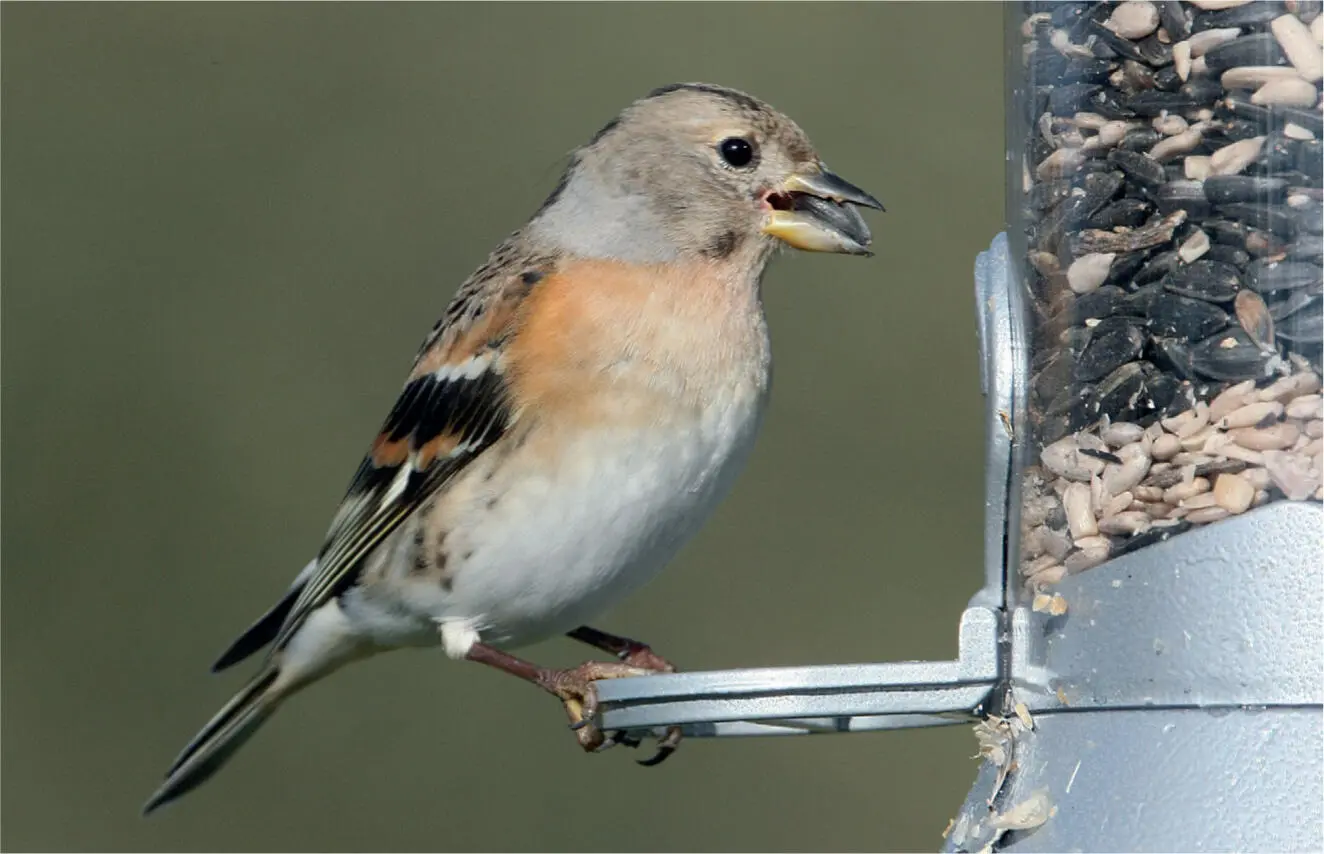
FIG 10. Garden feeding stations have been implicated in the transmission of disease between different species of garden bird, but the presence of supplementary food also has positive benefits for birds like this Brambling. (Jill Pakenham)
ARE GARDENS IMPORTANT?
As the figures presented within this chapter demonstrate, gardens and the wider built environment support significant proportions of the breeding populations of certain bird species. In addition, gardens and their associated resources may be important for particular birds at other times of the year or during periods when the availability of key resources within the wider environment is at a seasonal low. This underlines that gardens are important, and not just for species flagged as being of conservation concern. How we manage our gardens and the resources they contain has consequences for bird populations and, as we shall see later in this book, may also help to drive evolutionary change. It is important to remember that garden bird populations do not exist in isolation, since birds are well able to move between different habitats or regions. While gardens may not be as suitable as certain other habitats for breeding, they may be better in other ways, at least for some species.
We are, however, far from fully understanding the role that gardens play in a wider context, particularly in relation to source-sink dynamics, and it is certainly too early to be able to quantify the true value (or cost) of garden living for bird populations here in the UK, in Europe or North America, let alone elsewhere in the world. The mobility of birds makes it difficult to follow individuals throughout their full life cycle; in turn, this prevents us from being able to determine why particular individuals use gardens and the consequences or benefits of this use on future events in their lives. For a young Great Tit, raised in a piece of mature deciduous woodland bordering a city’s suburbs, the presence of suitable food in garden bird feeders may enable it to survive its first winter when it would otherwise have died. While this fortunate individual may fail to secure a prime woodland breeding territory the following year, and instead end up making a failed breeding attempt in a garden setting, it may still have the opportunity to occupy a woodland territory in a subsequent year. In the end, this individual’s lifetime reproductive success may still be better for having used a garden and its resources, than would have been the case had it only ever lived within a woodland site.

FIG 11. Gardens across the globe vary greatly in their structure and in the plants they contain, something that can reflect both cultural differences and local conditions. (Mike Toms)
CONCLUDING REMARKS
Before we leave this chapter and turn to look in more detail at particular aspects of the garden environment, it is worth reminding ourselves that the gardens present here in the UK, and across much of western Europe and North America, are often very different from those in other parts of the world. Thinking about gardens in a more global context forces you to move away from the predominantly recreational basis to gardens located within western Europe and North America. Many home gardens elsewhere are very different and provide families with space to engage in food production for subsistence or small-scale marketing. Such gardens may also play an important social or cultural role, perhaps acting as spaces within which knowledge related to agricultural practices can be shared. The management of these spaces creates structures and microclimates that are typically very different from the surrounding countryside; in this respect they can be considered alongside the more familiar urban and suburban gardens of western Europe, even though they look and act very differently (Guarino & Hoogendijk, 2004). It is known, for example, that ‘home gardens’ support high levels of inter- and intra-specific plant diversity, making them important in a global context, but far less is known about the role that they play for wider biodiversity and, in the context of this book, wild birds (Galluzzi et al., 2010). For the most part, however, we will just consider the gardens of western Europe, North America and Australasia in this book, something that also reflects where the greater amount of research has been carried out. The pattern of research worldwide isn’t just linked to particular geographic areas, since it has also been demonstrated that there is a positive and significant association between the degree of urbanisation of a species and how frequently it has been the subject of scientific study (Ibáñez-Álamo et al., 2017).
This chapter has highlighted the fact that gardens come in many different forms and that this has consequences for the communities of birds associated with them. The birds present in our gardens are the species that have, for the most part, adapted to the process of urbanisation to take advantage of the resources and other opportunities that gardens and the wider built environment provide. While some of these species populations are resident within the built environment, others make use of our gardens on a seasonal basis. Most UK gardens are located within highly urbanised landscapes; with urban land cover globally predicted to triple between 2000 and 2030 (United Nations, 2014), we can expect to see future changes in our garden bird communities. Such changes are part of an ongoing process that has altered the distribution of bird species, changed the composition of avian communities, brought about local extinctions and altered behaviour. It is these features and processes that we will examine of the following chapters, starting with feeding opportunities ( Chapter 2), then moving on to an examination of breeding behaviour ( Chapter 3
), disease risk ( Chapter 4
) and behaviour ( Chapter 5
).
Читать дальше
